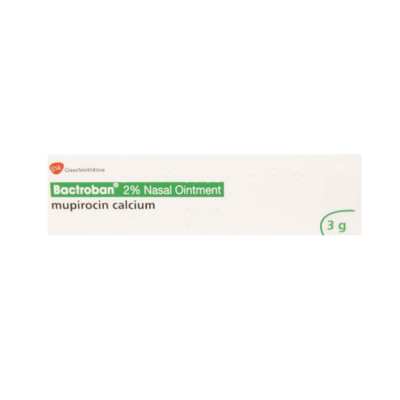Bactroban Nasal Ointment
- Effective antibiotic for skin conditions
- Effective against MRSA
- Prevents Infection Spread
Bactroban Nasal Ointment
Category:Nasal InfectionBactroban Nasal Ointment is a topical antibiotic used to treat nasal infections caused by Staphylococcus aureus, including nasal carriage of MRSA (methicillin-resistant Staphylococcus aureus). It works by preventing the growth of bacteria in the nasal passages.
Fetching Data...
All inclusive services
No extra costs
Free tracked delivery
Delivered in plain packaging
Prescription included
No consultation charges
Frequently Asked Questions for Bactroban Nasal Ointment
How are Bactroban cream, ointment, and nasal ointment different?
Bactroban is available in different formulations, including cream, ointment, and nasal ointment, and they are used to treat different types of infections.
-
Bactroban cream and ointment are used to treat skin infections caused by bacteria, such as impetigo, folliculitis, and infected eczema. The main difference between the cream and ointment is their consistency: the cream is lighter and more easily absorbed into the skin, while the ointment is thicker and forms a protective barrier on the skin.
-
Bactroban nasal ointment is used to eliminate bacteria in the nose, particularly methicillin-resistant Staphylococcus aureus (MRSA), which is a type of bacteria that can cause serious infections. It is applied inside the nostrils and is used to treat bacterial infections in the nasal passages, including nasal impetigo and other nasal infections.
It's important to note that Bactroban should be used only as directed by a healthcare professional and for the specific type of infection it is prescribed for. The duration of treatment and frequency of application may also differ depending on the formulation and the condition being treated.
What side effects does Bactroban have?
Bactroban cream and ointment, as well as nasal ointment, may cause side effects in some people. Here are some of the possible side effects of each type:
Bactroban cream and ointment:
- Skin irritation or rash
- Itching or burning at the site of application
- Allergic reactions such as hives, swelling, or difficulty breathing
Bactroban nasal ointment:
- Headache
- Nasal congestion or dryness
- Sore throat
- Change in taste or smell
How do I use each type of Bactroban?
The instructions for using each type of Bactroban may vary slightly. Here are general guidelines for using each type:
Bactroban cream and ointment:
- Wash your hands before and after applying the medication.
- Clean and dry the affected area before applying the cream or ointment.
- Apply a thin layer of the cream or ointment to the affected area and gently rub it in.
- Cover the area with a sterile gauze dressing, if necessary.
- Use the cream or ointment as directed by your healthcare provider.
Bactroban nasal ointment:
- Wash your hands before and after applying the medication.
- Tilt your head back and gently insert the nozzle into one nostril.
- Squeeze a small amount of the ointment into the nostril.
- Repeat with the other nostril.
- Gently press the sides of your nose together to spread the ointment.
- Use the nasal ointment as directed by your healthcare provider.
